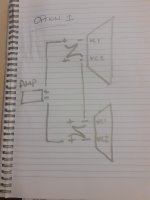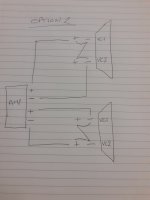Hi there DIYAudioers,
I’m hoping I could get some advice on wiring, phase, impedance and amplification choices for a stereo subwoofer pair (2 drivers per side) that I’m planning. (I checked existing threads and couldn’t see an answer.)
Basically, I have two main options I’m considering and I would like to understand their likely relative performance.
In both options, I intend to mount the drivers firing inward toward each other, so I understand I need to wire one driver per side out of phase so there is no cancellation.
However, I’m unclear on how to wire one driver out of phase when also wiring up two dual voice coil subwoofers per side.
I’ve set out what I see as my two main options below, with four questions at the end. The drivers are Dayton UM-18-22s and the amp is a Behringer NX6000. Some advice would be very appreciated! Thank you
Option 1 (per side)
Option 2 (per side)
Question 3: Does wiring the drivers in series and powering them through a single mono amp (Option 1) provide any performance advantages over wiring them individually, and powering them through dual mono amps (each amp receiving an identical mono signal from a splitter) with lower impedance (Option 2)?
Question 4: Are there any additional options I’m missing?
Thanks again!
Tom
I’m hoping I could get some advice on wiring, phase, impedance and amplification choices for a stereo subwoofer pair (2 drivers per side) that I’m planning. (I checked existing threads and couldn’t see an answer.)
Basically, I have two main options I’m considering and I would like to understand their likely relative performance.
In both options, I intend to mount the drivers firing inward toward each other, so I understand I need to wire one driver per side out of phase so there is no cancellation.
However, I’m unclear on how to wire one driver out of phase when also wiring up two dual voice coil subwoofers per side.
I’ve set out what I see as my two main options below, with four questions at the end. The drivers are Dayton UM-18-22s and the amp is a Behringer NX6000. Some advice would be very appreciated! Thank you
Option 1 (per side)
- 2 x Dual 2-ohm Voice Coil subwoofers, each driver rated at 1000 watts RMS
- Voice coils and drivers wired in series, resulting in 8-ohm impedance
- Single mono amplification @ 1600 watts RMS into 8 ohm (powering both drivers, ie 800 watts RMS per driver)
- Question 1: If this option is preferable, how do I wire one driver out of phase when wiring these drivers’ dual voice coils together AND wiring the drivers together in series? A diagram (or a link to one) would be great.
Option 2 (per side)
- 2 x Dual 2-ohm Voice Coil subwoofers, each driver rated at 1000 watts RMS
- Each driver has its voice coils wired in series, but drivers are not wired to each other - resulting in 4-ohm impedance per driver
- Dual mono amplification @ 3000 watts RMS per mono channel into 4 ohms
- I would use a balanced splitter to duplicate the signal coming out of my active crossover to feed identical signals into the dual mono amp
- Question 2: If this option is preferable, how do I wire one driver out of phase when wiring its dual voice coils in series? Again a diagram/link would be appreciated.
Question 3: Does wiring the drivers in series and powering them through a single mono amp (Option 1) provide any performance advantages over wiring them individually, and powering them through dual mono amps (each amp receiving an identical mono signal from a splitter) with lower impedance (Option 2)?
Question 4: Are there any additional options I’m missing?
Thanks again!
Tom
The method you have described works when the basket of one driver faces the cone of the other (push pull) If you have the cones facing each other you'll need to have both drivers in phase.
Here's a quick sketch of your 2 options.
Here's a quick sketch of your 2 options.
Attachments
Ok, here you go.
Speaker individual wiring: what Rob said. This makes each speaker a 4 ohm load. Less resistive heating loss per wire. Works great for home theater, where higher impedance speakers are the norm.
Question 1: rigging (leading towards all the others.)
For me, I would use whatever I had on hand to determine the wiring. Combined with the isovent configuration, it will tell you. For instance, if speaker on the inside of the sandwich quits, it's not easy to troubleshoot in the field. However, with all 4 speaker pairs running out the box into a distribution block, or individual speakers running straight to a 4 channel amp, troubleshooting becomes trivial.
This leads to the conclusion that if you're running a channel per speaker, it's cheaper to run each speaker 1 ohm instead of 4. This means heavier speaker leads, due to the 4x current situation. But a 1000w monoblock amp that's 1 ohm stable is common and not overly expensive. You may even find a 2000w monoblock that's 2 ohm stable for not hyper pricey. This is clean, 1%, pro audio, continuous power rating, not max music peak power. Car audio guys lean heavily this way. Unless they're sponsored, in which case they have to have at least 6 amplifiers in a rack somewhere.
One amp per isovent pair, half the troubleshoot by RCA input. Speaker wire cheap, amplifier power not cheap. Home audiophiles love this cuz 2 speakers per channel, big old anvil PA amps love 8 ohms. Pro audio gear usually exceeds the nameplate specs by a little for durability.
This bass box is going to be loud and proud, no matter what. It will be a 300 pound refrigerator no matter how much airspace you try to save by going isobaric. I'm guessing that the 18s are over 20 kilos apiece, so there's 200 pounds counting the speaker mounting whatever you build (plate / baffle / tube). Being a 3000+w box, gonna be 30 mm thick and bracing mandatory for long life, much less fidelity.
Speaker individual wiring: what Rob said. This makes each speaker a 4 ohm load. Less resistive heating loss per wire. Works great for home theater, where higher impedance speakers are the norm.
Question 1: rigging (leading towards all the others.)
For me, I would use whatever I had on hand to determine the wiring. Combined with the isovent configuration, it will tell you. For instance, if speaker on the inside of the sandwich quits, it's not easy to troubleshoot in the field. However, with all 4 speaker pairs running out the box into a distribution block, or individual speakers running straight to a 4 channel amp, troubleshooting becomes trivial.
This leads to the conclusion that if you're running a channel per speaker, it's cheaper to run each speaker 1 ohm instead of 4. This means heavier speaker leads, due to the 4x current situation. But a 1000w monoblock amp that's 1 ohm stable is common and not overly expensive. You may even find a 2000w monoblock that's 2 ohm stable for not hyper pricey. This is clean, 1%, pro audio, continuous power rating, not max music peak power. Car audio guys lean heavily this way. Unless they're sponsored, in which case they have to have at least 6 amplifiers in a rack somewhere.
One amp per isovent pair, half the troubleshoot by RCA input. Speaker wire cheap, amplifier power not cheap. Home audiophiles love this cuz 2 speakers per channel, big old anvil PA amps love 8 ohms. Pro audio gear usually exceeds the nameplate specs by a little for durability.
This bass box is going to be loud and proud, no matter what. It will be a 300 pound refrigerator no matter how much airspace you try to save by going isobaric. I'm guessing that the 18s are over 20 kilos apiece, so there's 200 pounds counting the speaker mounting whatever you build (plate / baffle / tube). Being a 3000+w box, gonna be 30 mm thick and bracing mandatory for long life, much less fidelity.
Last edited:
- Status
- This old topic is closed. If you want to reopen this topic, contact a moderator using the "Report Post" button.

